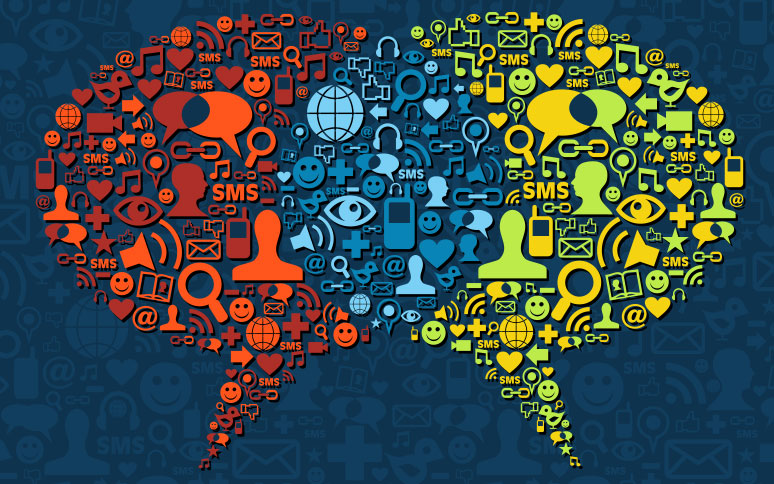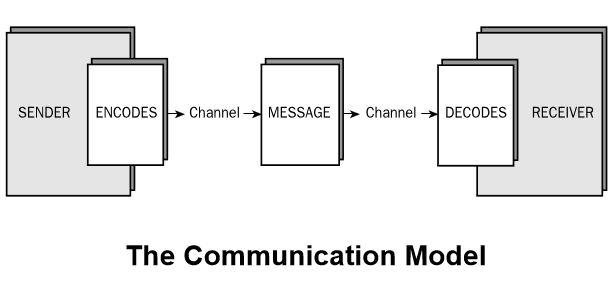Communication
 Graphics courtesy of Pryor LearningOpens in new window
Graphics courtesy of Pryor LearningOpens in new window
Communication is a not an easy word to define, nor is it an easy skill to master; however, it is critical to the successful functioning of every part of an organization. Communication links every part and level of the organization together from marketing, production, finance, HRMOpens in new window, and other departments on the one hand to the board, G-suite, division, department, groups or teams, and individual employees at the lowest levels of the organization. If leaders ensure that such communication flow is effective then they improve the potential for organizational success. |
What Is Communication?
- Communication is the “exchange of information between a sender and a receiver, and the inference (perception) of meaning between the individuals involved.”
- It is a circular and dynamic process in which people interpret and make sense of the information they exchange.
- It is important to understand that to be successful the information or ideas conveyed must be understood.
Good communication is often incorrectly defined by the communicator as “agreement” instead of “clarity of understanding.”
If someone disagrees with us, we may often assume the person just did not fully understand our position; but a person can clearly understand us and simply not agree.
In fact, when a leader concludes that a lack of communication must exist because a conflict between two employees has continued for a long time, a closer look often reveals that the two are communicating, they just don’t agree.
The importance of effective communication for leaders cannot be overemphasized, for one specific reason—everything a leader does involves communicating. Not some things, but everything! Visioning, strategic planning, and execution all require communication.
Leaders cannot make a decision without information, and that information has to be communicated. Once a decision is made it must be communicated to others or no one will know about it.
The best idea, the most creative suggestion, or the finest plan cannot take form without communication. Indeed, it would be safe to say that most leaders spend upwards of 85% of their time engaged in some form of communication.
To function effectively within the organization, leaders have to be able to effectively communicate horizontally and vertically. Poor communication skills carry a great deal of liability. Leaders who do not communicate effectively are at a disadvantage and do not thrive in organizations.
The Communication Process
Communication is neither simple nor clear-cut. Communication can be thought of as a problem-solving activity in which individuals may address the following questions:
- What is the situation?
- What are some possible communication strategies?
- What is the best course of action?
- What is the best way to design the chosen message?
- What is the best way to deliver the message?
Communication can also be viewed as a form of social information processing in which receivers interpret messages by cognitively processing information.
As a result, a perceptual model of communication has been introduced that depicts it as a process in which receivers create meaning in their own minds. Figure X-1 depicts this process and is discussed briefly in the paragraphs below.
 Figure X-1 Basic communication process
Figure X-1 Basic communication process
|
The communication process consists of the sender, message, and receiver. The sender is the person or group wanting to communicate information—the message. The receiver is the person, group, or organization for whom the message is intended. |
Encoding
Communication begins when a sender encodes an idea or thought.
Encoding means translating thoughts into a form or language that can be understood by others. This language becomes the foundation of the message.
For example, if a leader wants to communicate with their work groupOpens in new window or teamOpens in new window about an upcoming projectOpens in new window, she or he must first think about what information to communicate. Once the leader has resolved this issue in their own mind (encoding), the next step is to select a medium in which to communicate.
Selecting a Medium
Leaders can communicate through a variety of media. These include face-to-face conversations and meetings, telephone calls, charts and graphs, and the many digital messaging forms—e-mail, texting, voice mail, video-conferencing, Twitter, Facebook, Blackboard, and others.
Decoding and Creating Meaning
DecodingOpens in new window, the process of interpreting or making sense of a message, occurs when receivers receive a message. Just as a sender must encode messages in preparation for transmission through communication channels, receivers must sense and interpret the symbols and then decode the information back into images, emotions, and thoughts that make sense to them.
When a leader communicates with a direct report about a work assignment, for example, the direct report decodes the message when they received it. When messages are decoded exactly as the sender has intended, the images of the sender and the images of the receiver match, and effective communication occurs.
The perceptual model of communication assumes the receiver creates the meaning of a message in her or his mind. This means different people can interpret the same message differently.
Feedback
The first round of feedbackOpens in new window occurs when the original receiver expresses a reaction to the sender’s message. Once the initial sender has obtained this feedback, they are likely to decode it and send corresponding feedback.
This response might include confirmation that the original message was clear or a request for additional information. If the sender does not receive feedback regarding the message, it is possible that the message will be misinterpreted. This process continues until the sender and receiver believe they have effectively communicated.
Noise
Noise is anything that interferes with the transmission and understanding of a messageOpens in new window.
There are many sources of noiseOpens in new window: language differences, speech impairment, illegible handwriting, inaccurate statistics, poor hearing and eyesight, environmental noises, other people talking, affects all the links in the communication process and is a main contributor to communication breakdown as briefly discussed under the next heading.
Nonverbal communicationOpens in new window also is a source of noise, as a are cross-cultural differences between senders and receivers, and the physical work environment.
How Communication Breaks Down
If everyone were to have the same experiences, all messages would be encoded, transmitted, and decoded alike. Symbols would have the same meanings for everyone, and all communication would be received as the senders intended.
This is far from reality, however, as people differ in their personal histories, ways in which they experience things and emotional responses, leading to differences in the ways in which communications are encoded, transmitted, received, and understood.
Different people attach different meanings to the words, pictures, sounds, and gestures used during communication. Difficulty with the encodingOpens in new window and decodingOpens in new window of images is not the only factor that affects the effectiveness of communication between people. As noted in the last section, noise is physical and psychological forces that can disrupt communication.
Physical noise refers to conspicuous distractions in the environment that make it difficult to hear or pay attention.
For example, when the environment is excessively hot or excessively cold, or when one is in a noisy office, one may tend to focus more concern on the situation than on the message.
Physical noise can inhibit communication at any point in the process— in the senderOpens in new window, in the messageOpens in new window, in the channelOpens in new window, or in the receiverOpens in new window.
Psychological noise alludes to mechanisms within individuals that restrict a sender’s or receiver’s ability to express and/or understand messages clearly.
For example, senders with limited vocabularies may have difficulty translating images into symbols that can be understood easily by receivers.
Receivers with inflated self-concepts may filter messages that disagree with their self-perceptions and put energy into defending themselves rather than into understanding the messages. Psychological noise most often results in defensiveness that blocks the flow of communication between sender and receiver.
With the many ways in which communications can be encodedOpens in new window, channeledOpens in new window, and decodedOpens in new window, there is little wonder why so many difficulties exist when people attempt to communicate with one another. Yet communication processes become more complex.
Discussing communication in terms of sender-receiver implies one-way communication. However, human communication often is a two-way process in which each party shares sending and receiving responsibilities. As the quantity of people taking part in a communication increases, the potential for errors in encoding and decoding increases, along with the physicalOpens in new window and psychological noiseOpens in new window.
See also:
- The Role of Perception in CommunicationOpens in new window
- Formal/Informal Communication Networks & The GrapevineOpens in new window
- Communication MediaOpens in new window
- Communication Barriers to AvoidOpens in new window
- Improving Communications Between the Sexes and GenerationsOpens in new window
- Wrench, J. S., & Punyanunt-Carter, N. (2012). An introduction to organizational communication. Retrieved from https://2012books.lardbucket.org/books/an-introduction-to-organizational-communication/index.html
- Wyer, R. S., Jr., & Shrum, L. J. (2015, April). The role of comprehension processes in communication and persuasion. Media Psychology, 18(2), 163 – 195.
- Luthra, A., & Dahiya, R. (2015). Effective leadership is all about communicating effectively: Connecting leadership and communication. International Journal of Management and Business Studies, 5(3), 43 – 48.

